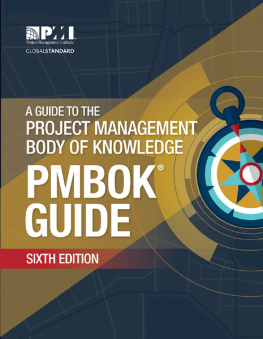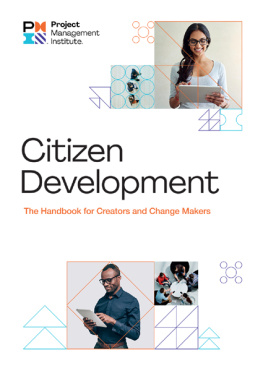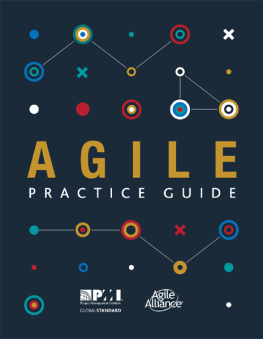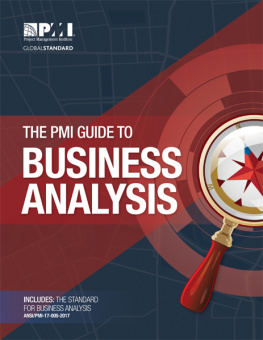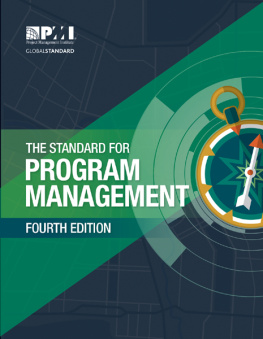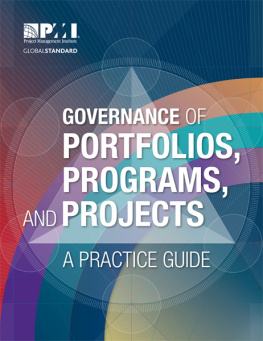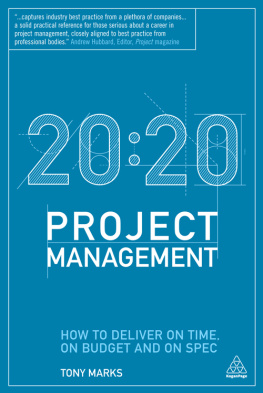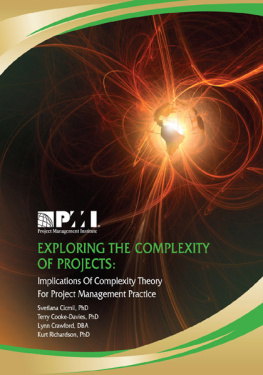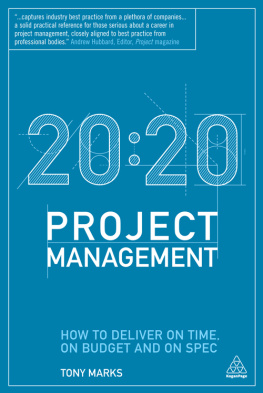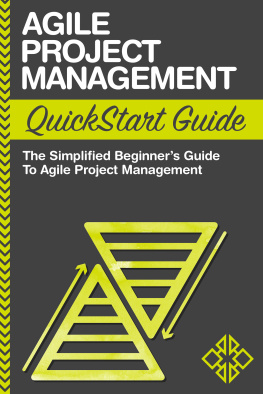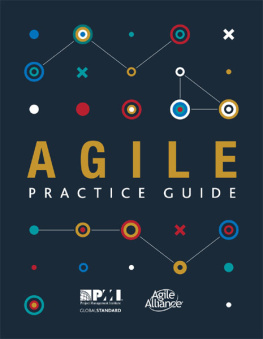Project Management Institute - Business Analysis for Practitioners: A Practice Guide
Here you can read online Project Management Institute - Business Analysis for Practitioners: A Practice Guide full text of the book (entire story) in english for free. Download pdf and epub, get meaning, cover and reviews about this ebook. year: 2015, publisher: Project Management Institute, genre: Business. Description of the work, (preface) as well as reviews are available. Best literature library LitArk.com created for fans of good reading and offers a wide selection of genres:
Romance novel
Science fiction
Adventure
Detective
Science
History
Home and family
Prose
Art
Politics
Computer
Non-fiction
Religion
Business
Children
Humor
Choose a favorite category and find really read worthwhile books. Enjoy immersion in the world of imagination, feel the emotions of the characters or learn something new for yourself, make an fascinating discovery.

- Book:Business Analysis for Practitioners: A Practice Guide
- Author:
- Publisher:Project Management Institute
- Genre:
- Year:2015
- Rating:4 / 5
- Favourites:Add to favourites
- Your mark:
- 80
- 1
- 2
- 3
- 4
- 5
Business Analysis for Practitioners: A Practice Guide: summary, description and annotation
We offer to read an annotation, description, summary or preface (depends on what the author of the book "Business Analysis for Practitioners: A Practice Guide" wrote himself). If you haven't found the necessary information about the book — write in the comments, we will try to find it.
Project Management Institute: author's other books
Who wrote Business Analysis for Practitioners: A Practice Guide? Find out the surname, the name of the author of the book and a list of all author's works by series.
Business Analysis for Practitioners: A Practice Guide — read online for free the complete book (whole text) full work
Below is the text of the book, divided by pages. System saving the place of the last page read, allows you to conveniently read the book "Business Analysis for Practitioners: A Practice Guide" online for free, without having to search again every time where you left off. Put a bookmark, and you can go to the page where you finished reading at any time.
Font size:
Interval:
Bookmark:
Project Management Institute
Library of Congress Cataloging-in-Publication Data
Business analysis for practitioners : a practice guide.
pages cm
Includes bibliographical references.
ISBN 978-1-62825-069-5 (pbk. : alk. paper) -- ISBN 1-62825-069-0 (pbk. : alk. paper) 1. Project management. 2. Business planning. 3. Management. I. Project Management Institute.
HD69.P75B8745 2015
658.4013--dc23
ISBN: 978-1-62825-069-5
Published by:
Project Management Institute, Inc.
14 Campus Boulevard
Newtown Square, Pennsylvania 19073-3299 USA
Phone: +610-356-4600
Fax: +610-356-4647
Email:
Internet: www.PMI.org
2015 Project Management Institute, Inc. All rights reserved.
PMI, the PMI logo, PMBOK, OPM3, PMP, CAPM, PgMP, PfMP, PMI-RMP, PMI-SP, PMI-ACP, PMI-PBA, PROJECT MANAGEMENT JOURNAL, PM NETWORK, PMI TODAY, PULSE OF THE PROFESSION and the slogan MAKING PROJECT MANAGEMENT INDISPENSABLE FOR BUSINESS RESULTS. are all marks of Project Management Institute, Inc. For a comprehensive list of PMI trademarks, contact the PMI Legal Department. All other trademarks, service marks, trade names, trade dress, product names and logos appearing herein are the property of their respective owners. Any rights not expressly granted herein are reserved.
PMI Publications welcomes corrections and comments on its books. Please feel free to send comments on typographical, formatting, or other errors. Simply make a copy of the relevant page of the book, mark the error, and send it to: Book Editor, PMI Publications, 14 Campus Boulevard, Newtown Square, PA 19073-3299 USA.
To inquire about discounts for resale or educational purposes, please contact the PMI Book Service Center.
PMI Book Service Center
P.O. Box 932683, Atlanta, GA 31193-2683 USA
Phone: 1-866-276-4764 (within the U.S. or Canada) or +1-770-280-4129 (globally)
Fax: +1-770-280-4113
Email:
Printed in the United States of America. No part of this work may be reproduced or transmitted in any form or by any means, electronic, manual, photocopying, recording, or by any information storage and retrieval system, without prior written permission of the publisher.
The paper used in this book complies with the Permanent Paper Standard issued by the National Information Standards Organization (Z39.481984).
10 9 8 7 6 5 4 3 2 1

The Project Management Institute, Inc. (PMI) standards and guideline publications, of which the document contained herein is one, are developed through a voluntary consensus standards development process. This process brings together volunteers and/or seeks out the views of persons who have an interest in the topic covered by this publication. While PMI administers the process and establishes rules to promote fairness in the development of consensus, it does not write the document and it does not independently test, evaluate, or verify the accuracy or completeness of any information or the soundness of any judgments contained in its standards and guideline publications.
PMI disclaims liability for any personal injury, property or other damages of any nature whatsoever, whether special, indirect, consequential or compensatory, directly or indirectly resulting from the publication, use of application, or reliance on this document. PMI disclaims and makes no guaranty or warranty, expressed or implied, as to the accuracy or completeness of any information published herein, and disclaims and makes no warranty that the information in this document will fulfill any particular purposes or needs. PMI does not undertake to guarantee the performance of any individual manufacturer or seller's products or services by virtue of this standard or guide.
In publishing and making this document available, PMI is not undertaking to render professional or other services for or on behalf of any person or entity, nor is PMI undertaking to perform any duty owed by any person or entity to someone else. Anyone using this document should rely on his or her own independent judgment or, as appropriate, seek the advice of a competent professional in determining the exercise of reasonable care in any given circumstances. Information and other standards on the topic covered by this publication may be available from other sources, which the user may wish to consult for additional views or information not covered by this publication.
PMI has no power, nor does it undertake to police or enforce compliance with the contents of this document. PMI does not certify, test, or inspect products, designs, or installations for safety or health purposes. Any certification or other statement of compliance with any health or safety-related information in this document shall not be attributable to PMI and is solely the responsibility of the certifier or maker of the statement.
Business Analysis for Practitioners: A Practice Guide is a complementary document to PMI's foundational standards. This practice guide provides guidance on how to apply effective business analysis practices on programs and projects and to drive successful business outcomes. This practice guide provides those with an interest in and commitment to the business analysis discipline the following:
- Diverse collection of both long-established and recent business analysis techniques and practices, defined and explained by experienced business analysis professionals and practitioners; and
- Description of how these techniques and practices can be used including many specific examples.
The information in this practice guide will help readers to:
- Consider which practices and techniques are appropriate for use in their own organizations, and
- Consider how to adapt and adjust techniques and practices to meet organizational and cultural needs without diluting the quality of business analysis which they support.
This practice guide is intended to encourage discussion related to areas of practice where there may not yet be consensus. The discipline of business analysis and its associated roles continue to evolve. Some of the most significant drivers of this evolution are:
- Increased business focus on the ability to accommodate rapid change,
- Increased project focus on delivering value as efficiently as possible, and
- New and evolving approaches for stakeholders and project team members to collaborate with each other to deliver successful projects, which drive business value.
Additionally, the choice of business analysis practicesand how organizations tailor what they choose to implementis highly dependent on organizational, cultural, and methodological norms. These choices are also impacted by how much change an organization is willing and able to embrace. There is no expectation that every practitioner of business analysis will use every technique noted in the practice guide, for example:
- Some practitioners may consider some of the techniques to be traditional and therefore too confining. PMI recognizes that agile practitioners may desire more adaptive techniques.
- Other practitioners may find that some of the techniques are too new and would potentially introduce risk or complexity.
With all of these considerations in mind, Business Analysis for Practitioners: A Practice Guide offers these practices as a starting point to identify thought processes and approaches that may improve how organizations and practitioners approach and achieve effective business analysis.
Font size:
Interval:
Bookmark:
Similar books «Business Analysis for Practitioners: A Practice Guide»
Look at similar books to Business Analysis for Practitioners: A Practice Guide. We have selected literature similar in name and meaning in the hope of providing readers with more options to find new, interesting, not yet read works.
Discussion, reviews of the book Business Analysis for Practitioners: A Practice Guide and just readers' own opinions. Leave your comments, write what you think about the work, its meaning or the main characters. Specify what exactly you liked and what you didn't like, and why you think so.

